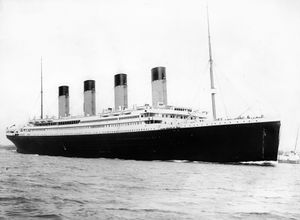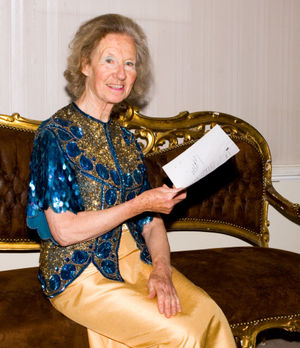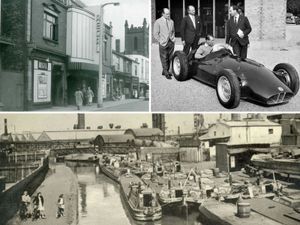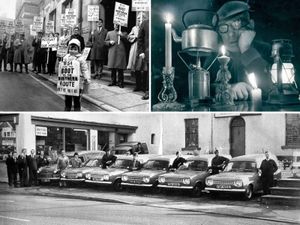Cellist kept on playing as the Titanic went down
He must surely have been bursting with pride. The boy from the heart of the West Midlands was now about to entertain some of the world’s movers and shakers, the rich and the famous, aboard the ship everybody was talking about.
John Wesley Woodward had been chosen to play the cello on the Titanic’s maiden voyage. He was literally the poster boy for the trip of a lifetime, his picture adorning the promotional material for the ship’s first outing.
Tragically, it would also be the ship’s last and he would form part of the orchestra that went down with the ship, playing Nearer my God to Thee.
It is 110 years today since RMS Titanic sank on its maiden voyage. On April 14, 1912, the ship which was supposedly unsinkable, sank, after striking an iceberg in the North Atlantic Ocean.

RMS Titanic lived up to its name, the world’s biggest liner at the time, a show-stopping monument to British shipbuilding technology, and flagship of the White Star Line. She left Southampton on April 10, stopping at Cherbourg and Queenstown in Ireland, before heading west towards New York.
About 375 miles south of Newfoundland, the ship struck an iceberg, ripping a hole in five of the 16 watertight cells. The ship was designed to withstand damage to four of them. Of the estimated 2,224 passengers and crew aboard, more than 1,500 died, making it one of the worst shipping disasters of all time.
John Wesley Woodward, usually known by his second name, was born on September 11, 1879, the son of Joseph Woodward, an iron moulder and manager of a holloware factory in West Bromwich, and his wife Martha. The youngest of nine children, he lived in Hawkes Lane in the Hill Top area of the town.
His father died aged 49 in 1884 and the family remained in West Bromwich until his brother Thomas secured work as a professional singer and lay clerk at Magdalen College, Oxford, later moving the rest of the family with him.

He left Oxford to join the Duke of Devonshire’s band at Eastbourne but that enterprise fell through circa 1909 so he joined the White Star Line, his first voyage being to Jamaica.
He had been aboard the Titanic’s sister ship the Olympic – along with the Titanic’s captain Edward J Smith – when she collided with HMS Hawke in 1911 and he narrowly escaped injury.
The 32-year-old’s body was never recovered, but he is commemorated on his family’s headstone at Heath Lane Cemetery, in West Bromwich. Ten years ago, a new memorial plaque was installed at the cemetery. Also aboard the ill-fated liner were the Davies brothers from Harwood Street, West Bromwich, and their uncle, James Lester.
Alfred Davies, 25, had only married the day before. His older brother had left seven years earlier to make a new life near Detroit and the family was so impressed with what he had achieved they decided they should all move to America.
Alfred, and his brothers John, 23, and Joseph, 17, decided they would head for a new life and were joined by James Lester, from the Sedgley area of Dudley, who had sold his furniture to finance the expedition.
Alfred’s new bride returned to live with her mother as she waited for her husband to become settled. “The wedding took place at Oldbury Parish Church on Monday and the newly-wedded wife returned to live with her mother, Mrs Cartwright, at Brades Village, until her husband could send for her.” the Star reported.
The four men nearly missed reaching Titanic after confusion about their train times, but they just made it in time for the train from Birmingham.
The men wrote letters from both Southampton and Queenstown, where the ship had called, saying they were enjoying a comfortable passage – and that was the last anybody heard from them.
The parents of the Davies brothers spoke to a Star reporter about the tragedy. “With tears breaking his voice, the father of the young men described them as fine big lads, always steady, and the mother added the remark that they were the best of sons,” the newspaper said.
There was such a thing as a good trip on the Titanic, as Johanna Vardon is able to testify. Her grandmother Barbara Lenox-Conyngham and family, having visited relatives in Shropshire, boarded the Titanic at Southampton and got off at Cherbourg. “My grandmother was a very shrewd lady and we were dreadful sailors in the family, so she absolutely forbade any member of the family to go across the English Channel in anything else but a liner,” says Miss Vardon from Newport.
“So when she saw an advertisement for the Titanic’s maiden voyage, she decided that was how they would go to France. They were going to see the Bayeux Tapestry and go on to Paris.” The family party, all with the surname Lenox-Conyngham, also included Barbara’s sister-in-law Alice, her 12-year-old aunt Eileen and Eileen’s 11-year-old brother Denis. All travelled First Class.
Miss Vardon says: “The captain saw the two children coming on board with their mother and aunt and said to one of the officers: ‘You see these two children – keep them out of mischief.
“Why don’t you take them on a cook’s tour?’ A ‘cook’s tour’ is when you are taken to see everything on the ship.” And so it was that two young children had what may have been a unique view of the opulence and grandeur of the magnificent but ill-fated liner.
Miss Vardon says: “I believe my aunt and her brother – and I believe she thought this too – were probably the only persons in the world who had been around the whole of the Titanic on a guided tour before the Titanic was sunk.” Miss Vardon has only vague childhood memories of her grandmother, a stately woman, but in contrast knew her aunt Eileen very well, living with her for a time in America, and in turn Eileen often came to stay in Shropshire.
She would listen in fascination as her aunt, who lived until she was 96, described in detail the sights she saw on board.

She has, too, a remarkable souvenir – an elegant evening top which her grandmother had on board the Titanic and, although nobody can be certain, probably wore on the ship. Other people from the West Midlands aboard the ship include Tyrell William Cavendish, of Little Onn Hall, Church Eaton, near Stafford, and his American-born wife Julia.
Mrs Cavendish survived but Mr Cavendish perished. Better fortune struck an American man in Walsall, who tried to buy tickets for the Titanic from the town’s Thomas Cook branch, but had left it too late.
The ship’s captain, Edward Smith was from Stoke, and his chief officer, Lt William Murdoch, was the cousin of Stourbridge clergyman Rev Dr Ewart.
There was one happy story to come out of the disaster.
Elizabeth Nye was rescued and met Cannock-born George Darby in New York. They married in 1913, and spent the rest of their lives in the US.





